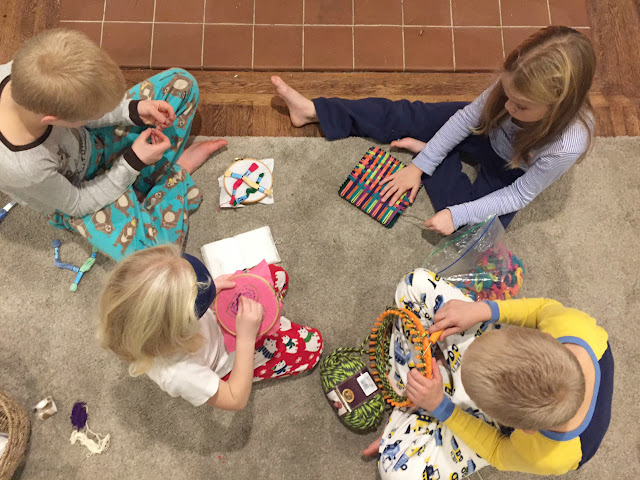My mom is writing this one, folks! Isn't that fun?!?!?! This will be a real treat for you since she doesn't overuse ????s and !!!!s as I do, but instead expresses herself perfectly with proper English usage and minimal, appropriate punctuation ;) Her name is Elaine and she's my favorite <3
A handful of years ago, my mom took my children to the Dollar store a week or two before Christmas, and it's become a sort of tradition since. The kid looks forward to their shopping day every year - they get one-on-one time with their grandmother and they get to browse a store that has something for everyone and choose carefully selected gifts for their siblings and parents.....
* * * * * *
We all know that it is more blessed to give than to receive (Acts 20:35), and of course we want our children to embrace that teaching. You know they love to put the envelope or the money in the collection plate on Sunday. But even when you explain what that’s all about, it’s not really their decision to give. So many moms and dads and teachers are helping children of all ages create hand-made gifts and this is absolutely wonderful. Having received more than my fair share of macaroni necklaces, woven baskets, hoops filled with cross stitch, and a two-foot Eiffel Tower made completely of Legos ©, I have seen the joy on the little givers faces when I am genuinely enthusiastic about the wonderfulness of the gift (and I STILL have several of those macaroni necklaces). Enthusiasm is key. One Christmas, many decades ago, a little guy in our house unwrapped a bag of plastic soldiers. Using his best manners, he exclaimed “I love this!” Then, “What is it?”
Hoping to spread that kind of joy around, for the past few years I’ve made several trips to the dollar store – each time with a young person – to shop. The first year, we made four trips to the store in a two hour period and I got some strange looks from the cashier. Early on, there was a good deal of guidance necessary - “I don’t think you can give your little brother a multi-function tool that includes several knives”. It gets easier every year, and this year I was especially pleased that the children began asking at the beginning of December about our shopping trip. Guidance is still necessary, and sometimes has to be quite firm – “We aren’t going to get anyone a (Barbie) doll.” A good deal of thought goes into the final choices. We tested a jeep and a Humvee to see which would go farther with one good push. We talked about the relative value of large and small spatulas for making pancakes. We discussed a younger sibling’s preference for alligators over dinosaurs. And we had a lot of fun imaging how much the other kids would like the gifts chosen. Several were chosen with the idea that this was something that could be played together (finger football, for example), making it even more fun.
This year we added a new wrinkle. Our parish is collecting household items for refugees that are settling in our area. Each child brought the gold coins that were found in the shoes left at the fireplace on the eve of Saint Nicolas’ feast day and bought two items from the list – soap, shampoo, sponges, toothpaste, kitchen cleaners. This past Sunday, they put the contributions that they had chosen into the box at the back of the Church.
Later this week we’ll have a gift wrapping party, and we’ll talk more about how lucky we are that we can give gifts to mom and dad and brothers and sisters. And on Christmas day, both receivers and givers will be blessed.
* * * * * *
As I have been on the receiving end of the this gifting tradition for the last several years, I can attest to the joy that the kids experience when they give me (or their dad, or sibling) that perfect gift. While the price certainly is right at Dollar Tree, I think it's the variety that makes it the perfect shopping destination for little ones. Where else can you buy a coffee mug for your mom, duct tape for your dad (always much appreciated!), bubble bath soap for the toddler, Star Wars pencils for your brother, and sparkly hair bows for your sister. It truly is the perfect place for kids to choose meaningful gifts that communicate "I chose this with you in mind... and I love you!"
May you all be abundantly blessed these few days of Advent and
may you have a very merry Christmas!












































